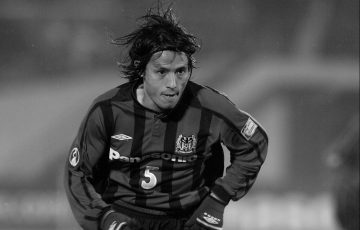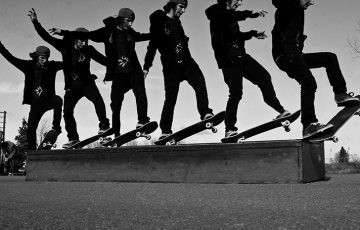 There is nothing that compares to the exhilaration, the reality and intense energy that is exuded at a professional MMA (mixed martial arts) fight. Simply the closest thing to two modern day warriors battling it out in a titanic clash of almost unfathomable power, watching a fight is testimony to the physical capabilities and tenacity of human beings at peak conditioning.
There is nothing that compares to the exhilaration, the reality and intense energy that is exuded at a professional MMA (mixed martial arts) fight. Simply the closest thing to two modern day warriors battling it out in a titanic clash of almost unfathomable power, watching a fight is testimony to the physical capabilities and tenacity of human beings at peak conditioning.
MMA is a hybrid mix of fighting skills that combines techniques of boxing, wrestling, kickboxing and submission grappling, and is unique in that fighters of various martial arts and fighting backgrounds are allowed to compete against each other. The ground fighting separates MMA from traditional fighting styles like boxing, karate and taekwondo, and fights are usually ended in one of three ways—referee stopping, submission or knock out.
MMA used to be illegal in almost every US state in the early 90s, and has changed from being a brutal curiosity to see which fighting style was more effective, to a popular spectator sport, governed by strict rules and popularized in the US by the UFC (Ultimate Fighting Championship).
While the sport took a while to gain the acceptance that it did in America, now out grossing boxing in pay per view revenue, Japan has a long tradition of martial arts and combat sports, and quickly took to the versatility of MMA. As a result it was well established by the late 90s, taking the Pro Wrestling fan base with it.
Alongside the meteoritic popularity of MMA as a spectator sport, numerous gyms and organizations mushroomed all over the country to produce both local Japanese and foreign fighters.
One such fighter is the Scottish born Stewart Fulton, who came to Japan in 2001. Catching the attention of Nobuhiko Takada, a famous fighter, and the one time boss of MMA organization Pride, he was invited to take a grueling physical test to enter his dojo.
Having passed, Stewart spent 10 months training under Takada and Kazushi Sakuraba (the legendary MMA fighter who took out Royce Gracie in 2000 in a 90 minute fight) doing a live-in at the dojo, learning under some of the most elite athletes in Japan. Stewart temporarily gave up life as he knew it, to train in a grueling day in, day out schedule that would include training, cooking, washing, barely sleeping for 6 out of 7 days of the week, and living on a diet that primarily consisted of chanko (a kind of Japanese stew).
“The appeal is the reality of it,” says Stewart of his love of fighting. “It is a very intense sport where you find out a lot about yourself as a person. It’s the ultimate, raw competitive sport; I mean it doesn’t get much simpler than testing your skills of physical domination over another human being! It’s not about bloodying someone up, or trying to kill them, it’s a lot about respect for each other as warriors.”
I had this support from people like Takada and Sakuraba, and to have the support from people like that is amazing. They fed me, they gave me clothes and a place to stay I didn’t need anything, but I had to give that all back in hard work. My motivation was really through them, and I am very competitive by nature so I wanted to fight. I wanted to know what it is like.”
Whilst Stewart only fights once or twice a year now, he still maintains a rigorous training schedule that consists of grappling (ne waza/jiu-jitsu) 3 times a week, boxing/kickboxing once/twice a week, weight training 3 times a week and running twice a week.
“I train at A Square in Nogizaka, and that’s owned by Kosaka Tsuyoshi. In America he is known as TK, and fought in the UFC. The training sessions there are open training sessions, so a lot of free fighters train there, so you get fighters from different competitions and different organizations.”
Fulton has competed in competitions such as Demolition, Cage Force, Rise, Shootboxing, and Tribelate. MMA in Japan is somewhat confusing in that it has a cavalcade of various organizations (the two most popular being Heroes and K-1), and to most Japanese, they would still be hazy on the difference in rules.
K-1 is probably the mostly widely recognized offshoot of MMA in Japan, but somewhat criticized for using glitzy and famous, but somewhat pathetic fighters such as the retired sumo wrestler Akebono and Bob Sapp. The sport was formed by a former karate fighter, Kazuyoshi Ishii, and uses the stand up techniques (only) of various martial arts. It is hugely popular in Japan, where it is broadcast on various TV networks. “It is so easy to watch for people who are not educated in martial arts,” says Fulton of K-1’s popularity, “with mixed martial arts they don’t understand grappling and ground work so it’s always standing, so it’s easy to watch, for the fans and the viewers to understand, so that is why it’s gotten so big. I wouldn’t be surprised if it becomes more global and we have a K-1 cup before long.”
There are a lot of smaller ones like Deep, for lesser-known pro fighters and even below that there are a lot of amateur tournaments, and the level is really high. So for anyone wanting to come over here and get experience, just competing in the amateur tournaments is excellent experience because the level is so high…”
While to the untrained eye, MMA looks like a bout of sheer strength, fighters are displaying not only their physical conditioning, but their mental strategy, their understanding of anatomy by knowing the vulnerable spots on the human body in order to weaken the opponent.
In the West, particularly, MMA is often portrayed as an act of brutality or senseless violence rather than a legitimate sport, and quite removed from highly disciplined practice like martial arts. Accordingly, MMA is still not sanctioned in New York, despite the fact that a UFC bout generates millions of dollars every year.
However, increased media attention and representation from eloquent fighters have somewhat raised the general awareness level so that people can appreciate MMA as something that requires much more than brawn.
A recent National Geographic program that looked into MMA, described the fighters as “powerful new age athletes,” and examined the strength and speed of MMA strikes using crash test dummies, and scientific monitoring.
The MMA fighters delivered more powerful punches than the boxers, and more powerful kicks than top level Muay Thai fighters, whose kicks are the equivalent to the force of a car crash at 35 kilometers an hour.
Despite this, there are fewer injuries in MMA than the other fighting sports because, in reality, much of the technique revolves around defense and strategy as much as offense, and the athletes train just as hard to sustain injuries as to inflict them.
Their conditioning enables their bones and muscles to withstand more trauma than the average human being. In fact, to date there have been no deaths, and many rules exist to protect the fighter’s safety.
In Japan however, there are few negative misconceptions about fighting, as there is a long history of martial arts, and very few people view MMA as being violent, or a “blood sport.”
“There are no negative misconceptions really!” says Fulton, “the roots are so deep because the budo and the martial arts roots are so deep here they see another side of it. The Japanese are a bit more separated from the reality of it. To them it’s not a blood fight or senseless violence, they can look at it like a story or a play. Something not quite as real to them”
The fans here are not drinking beer and shouting and screaming ‘kill him, kill him!’ They are a lot more respectful to the fighters. There is no booing, everyone gets a round of applause when they fight, whether they win or lose, unless of course they do something wrong.”
Given that there are numerous fights going on all over Japan, the opportunity to see matches are numerous, and coupled with the fact that some of the best gyms, (some with English speaking trainers) are all over Japan, it could well be the best way to train for physical strength, agility, fitness, focus, and discipline.
For those who are game, and as an absolute beginner interested in training as a hobby, what is the first step in learning?
“The first steps are learning basic boxing and kickboxing skills. This distance is where any fight starts, whether in the ring or if you are attacked on the street. Also, basic wrestling and take down skills are important since this is the next stage of hand-to-hand combat. Finally, grappling and submission skills are very important. Many fights end up on the ground so knowing what you are doing there is a must. Many gyms now offer classes in all these disciplines so you can work on all points.”
For those who would prefer to watch at a safe distance, the adrenalin of a match is contagious and the atmosphere of Japanese fights is unique, and pleasant.
“It’s very family-orientated here. Couples, and even families with kids will go to K-1,” says Fulton.
Check out the Japan MMA website (www.japan-mma.com) for more information, and prepare to be thrilled at the strength, fearlessness and physical prowess of these prime athletes.
Story by Manami Okazaki
From J SELECT Magazine, August 2009















Recent Comments